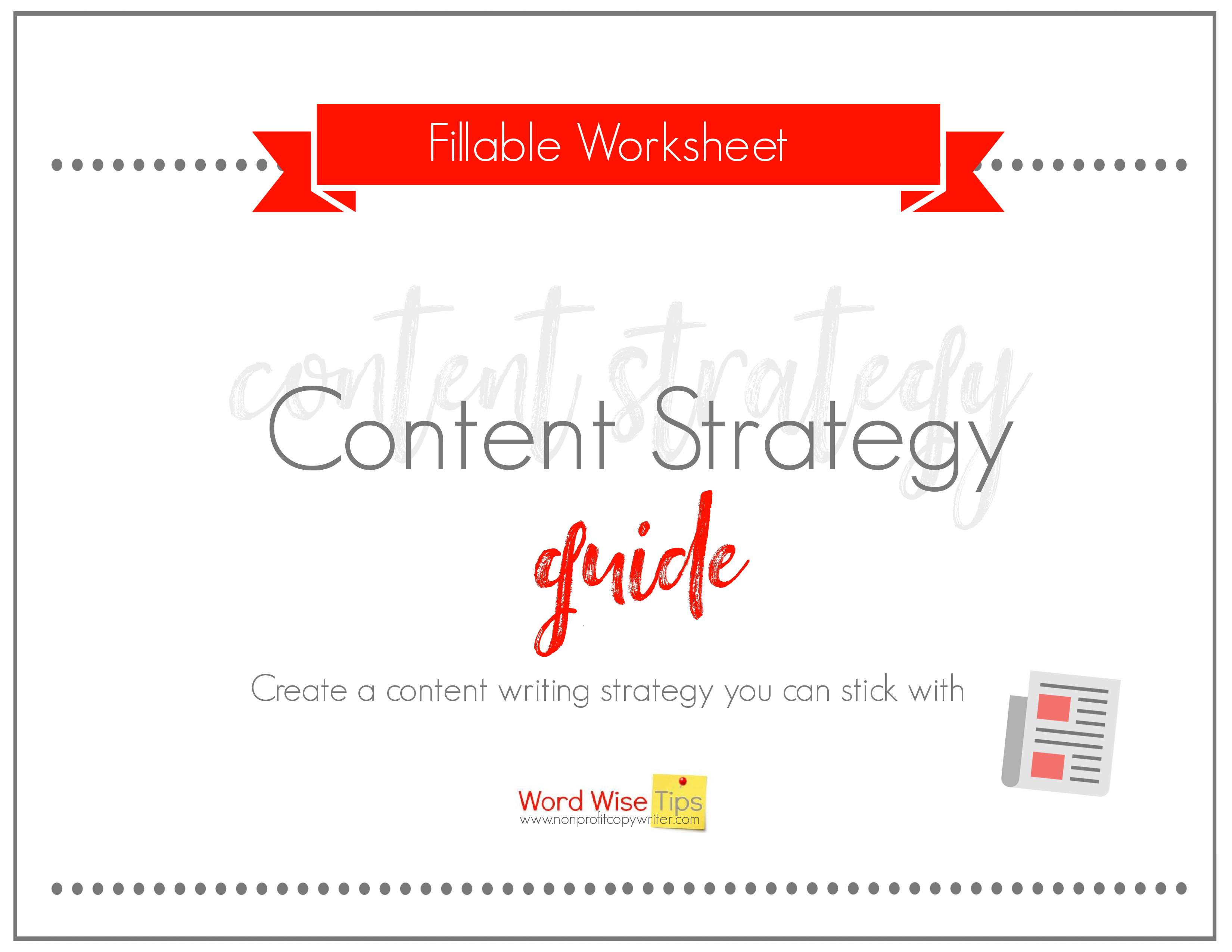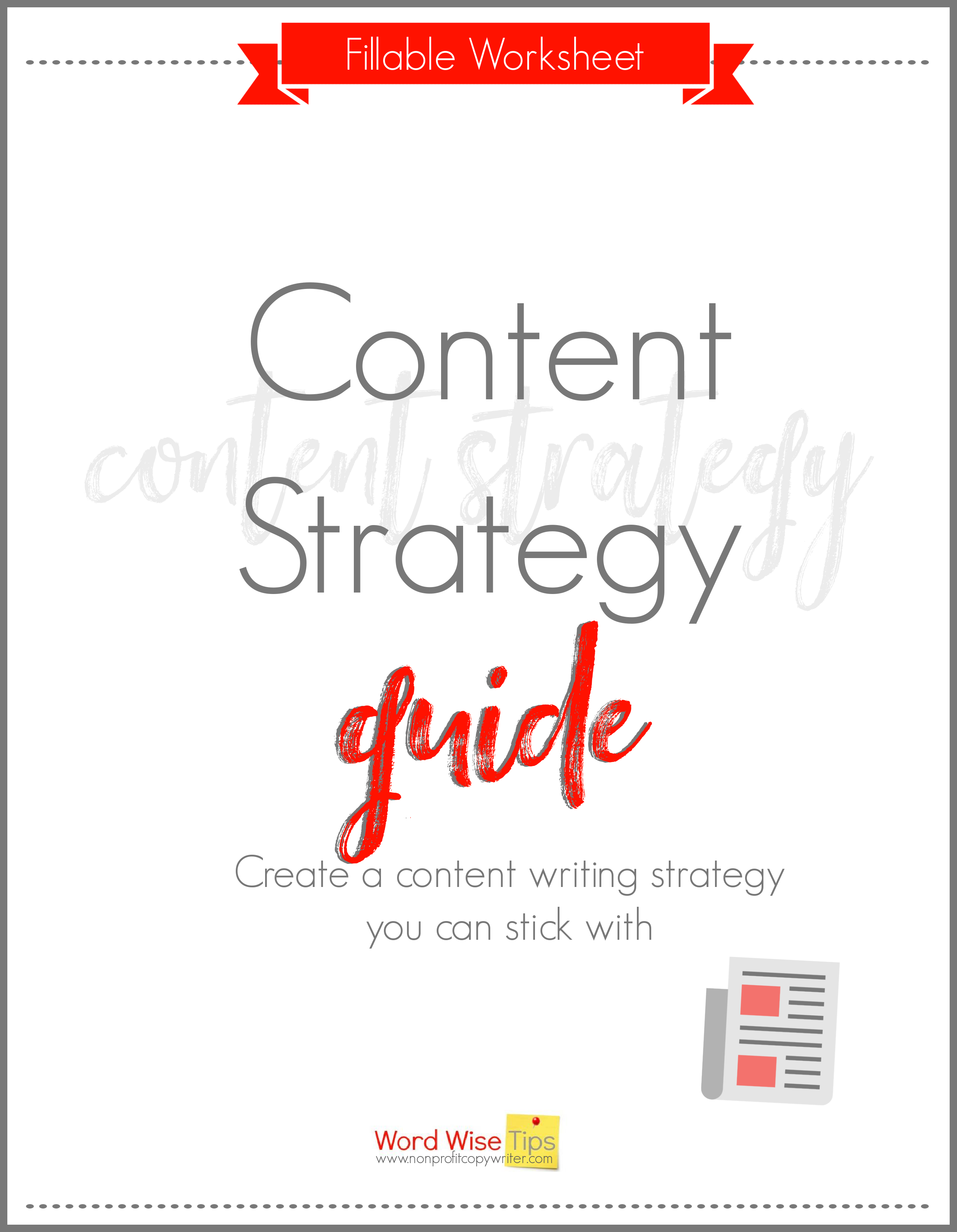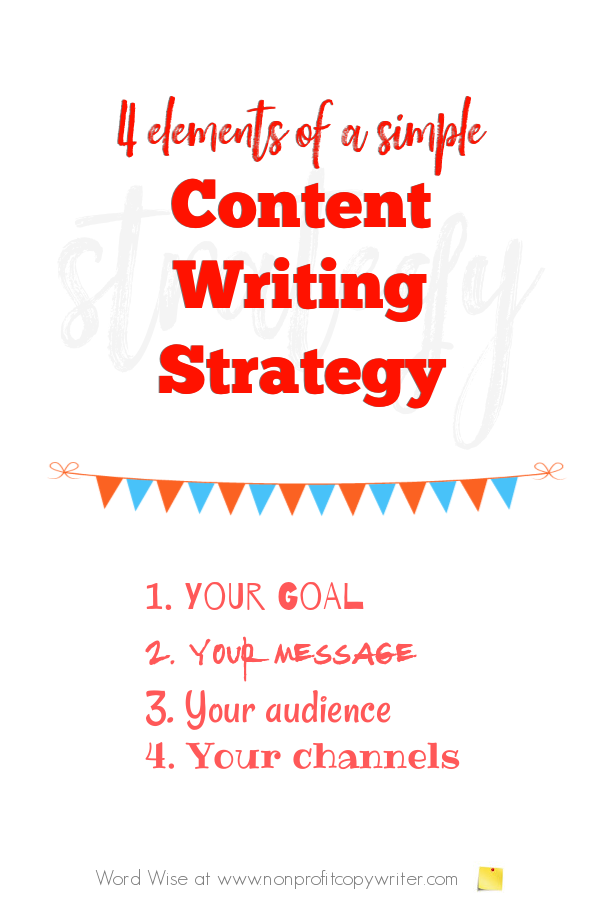Save Time: Get 5 Simple Writing Tips
you can put to use in 10 minutes
Create a Content Strategy You Can Stick With
Award-winning writer Kathy Widenhouse has helped hundreds of nonprofits and writers produce successful content , with 750K+ views for her writing tutorials. She is the author of 9 books. See more of Kathy’s content here.
Updated 3.6.25
If you’re a writer or freelancer or solopreneur or small biz owner, you need a content strategy. No, it needn’t be complicated. But you must have one if you want to make the best use of your time and build a following.
Don’t get put off by the marketing experts that summarize a content strategy as “the high-level planning, execution, governance, and ongoing management of the content lifecycle to sustain key business initiatives, drive traffic, increase engagement, multiply sales, and strengthen other business outcomes through content.” Or some other such high-level jargon.
If you’re a marketer, that kind of explanation makes sense. But if you don’t have an MBA, it may be difficult to translate that definition of a content writing strategy into a language you can understand … and next to impossible to carry it out. And I’m all about making content writing simple.
What is a content strategy, anyway?
A strategy is a broad plan. It’s a big-picture view — minus the minutiae. And you don’t create a strategy just because you want something to do. A good strategy always leads to a specific goal.
Let’s look at an example. In 1944, General George Patton commanded the U.S. Third Army division. His goal? Retake France for the Allies. His strategy? Use armored tanks. Tanks were able to navigate across different kinds of terrain. They offered protection for soldiers. Plus, tanks moved quickly. Tanks were Patton’s big-picture plan.
Patton used different tank movements in each battle, depending on the environment and the enemy’s position. In other words, he used various tactics to implement his strategy. But his overall strategy remained the same: use armored tanks. And he achieved the desired result. Patton helped the Allies to retake France.
Strategy vs tactics: what’s the difference?
Before we dig into creating your content strategy, let’s clarify. For the writer, a strategy is a broad plan you’ll follow as you create content. It addresses why, what, who, and where you produce content.
Tactics, on the other hand, are the smaller steps or specific activities you take to carry out your strategy — blogging and email marketing, for instance.
It’s a mistake to create a content writing strategy by choosing a few random steps — tactics — that other writers have told you work. Check with a dozen marketers and you’ll get a dozen different lists of what tactics to include in a content writing strategy. “Executing random tactics without a strategy can easily waste your time,” says David Risley of the Blog Marketing Academy. That approach is like throwing spaghetti against the wall and seeing what sticks.
Instead, your first order of business is to articulate your big-picture strategy. Once you put your strategy in place, you can choose tactics that best lead to your desired goal. Simple is best for the solopreneur and small biz owner. And “simple” doesn’t mean “simplistic.” Simple means clear and defined.
Your strategy needs to address four elements:
- Your goal (why are you writing content?)
- Your message (what is your key underlying principle?)
- Your audience (who are you writing to?)
- Your channels (where are you publishing?)
You can create a content writing strategy when you answer those four questions: why, what, who, and where.
Create a simple content writing strategy by answering 4 questions
1. Your goal: why are you writing content?
Why are you investing time and energy in producing content? When you have a clear goal, you can measure your content’s effectiveness. You can adjust or tweak your goal periodically for the best results.
And “because everyone’s doing it” is not an end result that will sustain you. You need to know your “why.” In other words, you need to write down your goal.
Some key content writing goals you may consider are to …
- Attract readers
- Generate leads
- Engage readers with content
- Build trust with readers
- Extend reach to different readers
- Acquire client work
Those goals are general. Anyone can have them. You need to personalize your “why.” Craft a goal that is measurable and sustainable. In other words, put specificity in it. Create SMART goals by writing out a goal that is specific, measurable, attainable, realistic, or time-bound — or all of these. Using the general writing goals above, you could write those general goals as SMART goals:
- Attract 1,000 more readers this year
- Generate 10 new leads each month
- Engage 3 readers in discussion every week
- Build trust by giving or receiving 5 shares each week
- Extend my reach to one new audience every 6 months
- Acquire a new client in the next month
Use this fillable, reusable Content Writing Guide
to create your own strategy.
2. Your message: what is your main idea?
Your message is more than a topic. It is the underlying theme or principle or angle that you want to communicate about that topic. You can write about plenty of sub-topics in your content, but all of them reinforce your main message.
To clarify your message, start with a broad topic. Then narrow it down to a specific niche within that topic. And finally, choose a slant on that niche.
Let’s look at an example. You operate a gardening website and your content writing goal (from #1) is to attract 1,000 more readers this year.
But gardening is a large topic. Unless you are the National Gardening Association, you need to niche down. First, narrow your topic and choose a more specific subject matter, such as:
- Vegetable gardening
- Rose gardening
- Commercial gardening
- Gardening with bulbs and tubers
- Container gardening
- Water gardening
- Indoor gardening
Let’s say you have narrowed your focus to a specific niche: commercial flower production. That is, you write about the ins and outs of running a wholesale fresh-cut flower growing business. Good job!
Once you’ve chosen a niche, you must drill down your message. What do you want readers to know about commercial flower production?
After thought and research, you determine that you offer content that explains how individuals can know what to grow in a local region, when to grow it, how to know what wholesalers are buying, how to find wholesale buyers in your area, and how to operate organically.
But even more important is what your content won’t cover. You won’t list fresh-cut flowers that a home gardener can grow on her apartment patio. Why? Because a patio isn’t large enough to operate a business. Nor will you write about running a florist shop. Those creative folks don’t get their hands in the dirt to plant ranunculus corms nor do they need to know a list of snapdragon seedling vendors.
You’ve clarified your message: a newcomer can learn how to operate a fresh-cut flower-growing business. Your site will show them how, no matter where they live.
How do you articulate your message? Choose a topic. Choose a niche. Choose a slant.
3. Your audience: who needs your message?
Your audience: who are they? A successful content writing strategy targets specific readers. The best way to do that is to create a composite profile of your audience — the project’s average reader.
To identify your audience, ask 3 key questions:
Who?
Who do you want to help? The temptation is to write to everyone on the planet. Don’t. Plenty of people are interested in gardening. But not every gardener is interested in operating a fresh-cut flower growing business. Nor is everyone who is interested in operating a fresh-cut flower business already a gardener.
What?
What do these readers need help with? Use an action verb to describe the help you offer. Your content helps your reader do something. Using our example, your “what” could be help. As in help with information, tools, and resources for operating a fresh-cut flower-growing business.
Why?
Why should this audience read your content? It’s not quite enough to target who needs help and what help you’ll give them. They need to know the benefit they will gain.
Put your three answers together to define your target audience. Using our example, you can describe your target readers like this:
My content will help gardeners and non-gardeners [who] get the information and resources they need [what] to start or build a successful fresh-cut flower growing business [why].
You can create an even more specific reader persona, if you wish, by identifying your ideal reader’s age, gender, income, race, marital status, family, job, level of education, beliefs or values, hobbies, and interests … other information that creates a detailed reader profile.
Once you have an image in your mind about who to write for, then you can keep that person front and center in your mind as you create specific content to meet that person’s needs.
4. Your channels: where will you publish your message?
Your content strategy needs to specify where you will publish your message. Where do you find these specific readers that need your message? And how do they find you?
A. Your hub
An online home allows people to find you and becomes the center of your operations. For most of us, this is a blog, website, or landing page. (Anyone can start a blog or website.) Your online home acts like the central hub of a wheel. Your other outreach efforts — like social media sites, guest posting, books, and courses — drive readers back to your hub. If you want to build a following, then building an online home is the place to start … and the place to continue to grow.
You can use plenty of tactics to build this online home: helpful pillar posts or pages. Content that is optimized with keywords so readers can find it. Regular, fresh new content. A valuable opt-in (also called a lead magnet) to gather email addresses so you can cultivate readers with useful information. Commenting sections so readers can interact with you. But those are various activities you’ll undertake to implement your strategy. The question is, “Do you have an online home in the first place?”
B. Online channels
Social media are digital tools that allow you to create and share online content publicly. You can choose from dozens of social media sites on which to post. And further, you can get tied in knots by being active on too many. But as you create your content writing strategy, be specific. Choose sites that have activity and interest in your specific niche.
You can build a following by broadcasting your message in other online channels: magazines, online publications, eBooks, and courses, for instance. What kinds of online channels offer content in your niche? List them in your strategy so you can create steps to reach them.
Going back to our example … a bit of research and analysis shows that fresh flowers are visual. Growers and vendors hang out on Instagram. Plus, you determine that prospective entrepreneurs can benefit from taking an online course about starting a commercial flower-growing business. Your strategy: concentrate your initial social media efforts on Instagram and on building an online course.
Once you determine how effective that channel is, you can adjust your online publication strategy accordingly.
C. Print channels
Self-publishing has opened all kinds of doors that allow you to build a following. You can publish any piece of content in print without going through a publishing house. Or you can submit queries to magazine editors, publishing houses, and agents who will help you find a home for your content.
D. Freelance pitches
As the demand for content has increased, so has the demand for content writers. Others will pay you to write words for them. You produce freelance pitches to those clients — which in turn, opens the door for you to write web content, social media posts, and print publications for your client. If you want to pursue work-for-hire, then freelance pitches are part of your content writing strategy.

One more content strategy tip
Re-evaluate your content strategy periodically, such as at the beginning of a new calendar year or at the beginning of each quarter. Ask the same four questions:
- What is your desired end result — your goal? You may need to expand or tighten your goal. Or perhaps it’s time to shift it.
- What’s your message? Has it changed or are you staying on point? And if you’ve published plenty of pillar content to support your message, then what are some secondary themes that help explain your message in a deeper way?
- Who needs your message? Have you drilled down to a more specific audience than you’ve written to in the past? Or have your readers’ needs changed?
- Where will you publish your message? Maybe you decide to focus on sharing content more on LinkedIn than on Pinterest. Or maybe you’ve decided to grow your email list. Or find clients that can use a content writer.
Your content strategy is a broad plan. But when you have a clear strategy in place, you can identify the specific steps — tactics — to use to reach your content writing goal, share your message, reach your most-interested readers, and publish in the places where they congregate. A good strategy saves time and targets your most valuable resource: your time. And when you have an effective content writing strategy in place, you can then identify how your “tanks” will move to take more ground.
More Content Writing Tips
The 3 Best Content Ideas (In Any Niche) ...
4 Types of Content: The Magic Is In the Mix ...
Avoid These 5 Deadly Content Writing Mistakes ...
The Case for Short vs. Long Form Content ...
How to Build a Content Writing Strategy for Your Blog or Website ...
How To Write Your Personal Brand Statement (with an easy template) ...
Use a Blog Post Worksheet to Save Time and Frustration ...
How to Create a Content Calendar ...
A Simple Content Calendar Template for Bloggers and Solopreneurs ...
Want Steady Traffic? Write 3 Different Types of Articles that Deliver ...
More Tips for Writing Content on our Pinterest board ...
Return from Create a Content Strategy You Can Stick With
to Nonprofit Copywriter home
As an Amazon Associate I earn from qualifying purchases.
Share This Page

Named to 2022 Writer's Digest list
BEST GENRE/NICHE WRITING WEBSITE


Stop Wasting Time!
Grab your exclusive FREE guide, "5 Simple Writing Tips You Can Put to Use in 10 Minutes or Less"














